Flee Germany – But Where To?
Thousands of Jews flee Germany in the first weeks and months after the Nazis seize power. Most of them are trying to escape persecution for their work as journalists or artists or for their political involvement in the workers’ parties. But most Jews in Germany do not initially consider leaving the country.
With the rise in discrimination and expropriation in the years that follow, increasing numbers of people seek to emigrate. However, the application of the “Reichsfluchtsteuer,” (Reich Flight Tax), which had been introduced into law in 1931 – seizing 25 percent of an emigrant’s assets, and imposing regulations impeding the transfer of the rest – makes it increasingly difficult to obtain entry permits for the target countries. Jewish organizations now see their main task as advising and supporting emigrants and preparing them for a new existence in the exile countries. By mid-1938, 143,000 of the approximately 500,000 Jews living in Germany in 1933 have left.
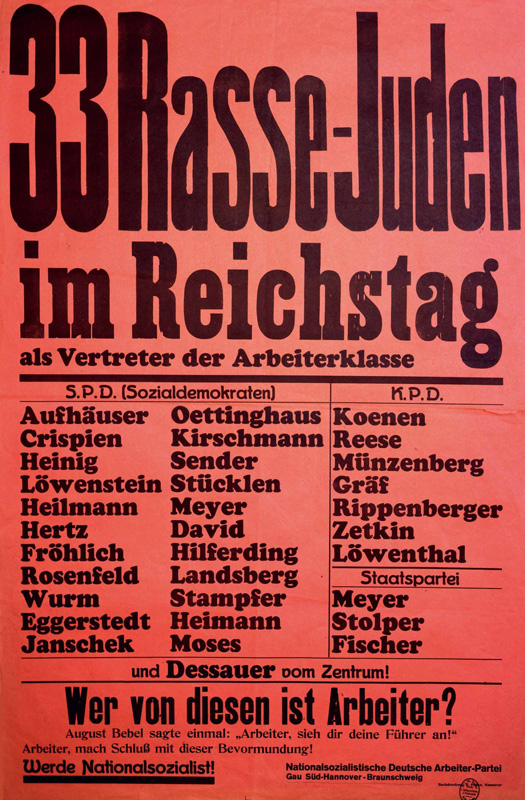
Nazi Party Poster: “33 Racial Jews in the Reichstag as Representatives of the Working Class,” ca. 1930
The Nazis persecute Jewish officials from the Social Democratic and Communist parties with particular hatred.
Bundesarchiv, Koblenz, Plakatsammlung
Nazi Party Poster: “33 Racial Jews in the Reichstag as Representatives of the Working Class,” ca. 1930
The Nazis persecute Jewish officials from the Social Democratic and Communist parties with particular hatred.
Bundesarchiv, Koblenz, Plakatsammlung

Sidonie Zippora (Toni) Sender, ca. 1931
Toni Sender comes from an Orthodox Jewish family. She has been a Social Democratic (SPD) member of the Reichstag since 1920 and editor of the SPD magazine Frauenwelt (Women’s World) since 1927. Following death threats, she flees on March 5, 1933 to Czechoslovakia, later moves to the Netherlands, and finally settles in the US in 1935.
Bild 30 Republikanische Werbestelle des Fackelreiter-Verlages Berlin, Photo: A. Bilder / Institut für Zeitgeschichte, München, IBA-00004423
Sidonie Zippora (Toni) Sender, ca. 1931
Toni Sender comes from an Orthodox Jewish family. She has been a Social Democratic (SPD) member of the Reichstag since 1920 and editor of the SPD magazine Frauenwelt (Women’s World) since 1927. Following death threats, she flees on March 5, 1933 to Czechoslovakia, later moves to the Netherlands, and finally settles in the US in 1935.
Bild 30 Republikanische Werbestelle des Fackelreiter-Verlages Berlin, Photo: A. Bilder / Institut für Zeitgeschichte, München, IBA-00004423
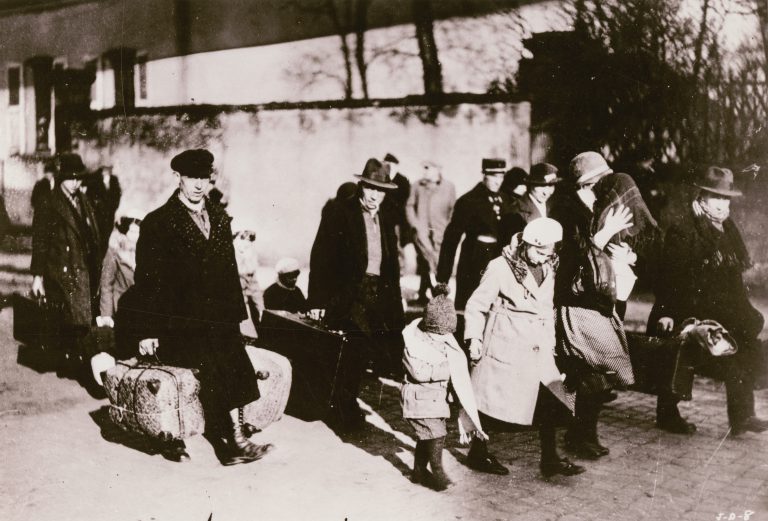
Arrival of Jewish refugees in France, Metz, 1936
After 37,000 Jews flee Germany in 1933, the following years see an annual emigration between 21,000 and 25,000. In the first half of 1938, 14,000 Jews leave. Many of them cross into the Netherlands, France, and Switzerland.
American Jewish Joint Distribution Committee Archives, New York, NY
Arrival of Jewish refugees in France, Metz, 1936
After 37,000 Jews flee Germany in 1933, the following years see an annual emigration between 21,000 and 25,000. In the first half of 1938, 14,000 Jews leave. Many of them cross into the Netherlands, France, and Switzerland.
American Jewish Joint Distribution Committee Archives, New York, NY
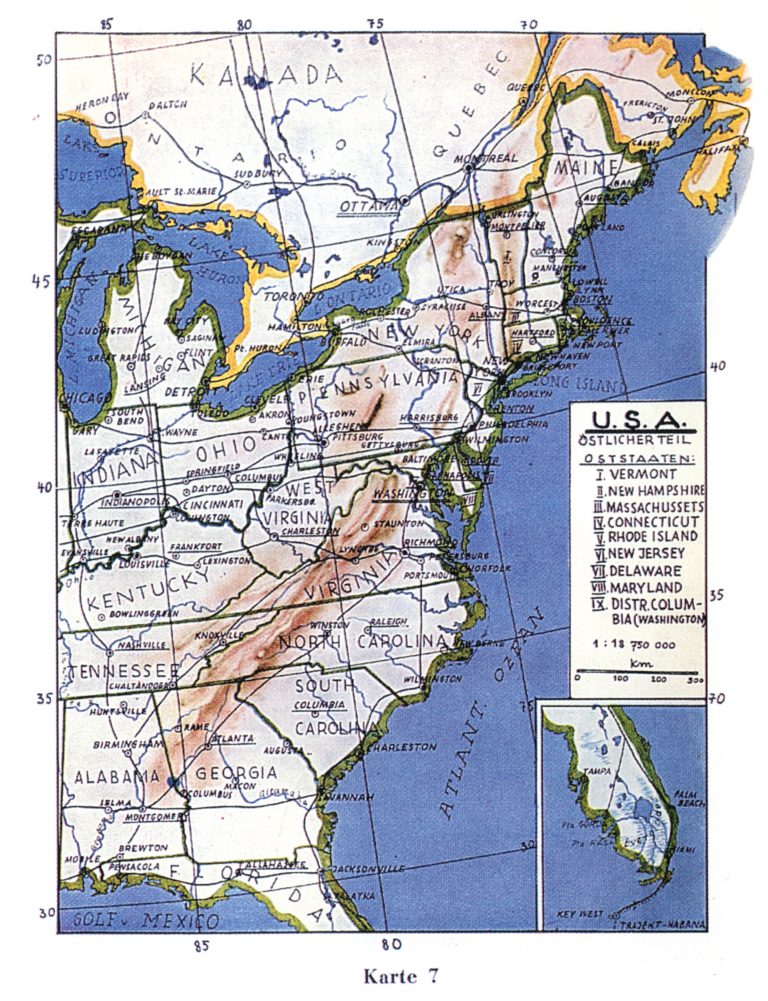
“PHILO-Atlas,“ Handbuch für die jüdische Auswanderung (Manual for Jewish Emigration), Jüdischer Buchverlag Philo, Berlin, 1938
The publisher, Dr. Ernst G. Löwenthal, has compiled essential information in paperback format on all possible emigration countries.
Deutsche Nationalbibliothek, Frankfurt am Main und Leipzig, https://portal.dnb.de/bookviewer/view/1032704535#page/n0/mode/1up
“PHILO-Atlas,“ Handbuch für die jüdische Auswanderung (Manual for Jewish Emigration), Jüdischer Buchverlag Philo, Berlin, 1938
The publisher, Dr. Ernst G. Löwenthal, has compiled essential information in paperback format on all possible emigration countries.
Deutsche Nationalbibliothek, Frankfurt am Main und Leipzig, https://portal.dnb.de/bookviewer/view/1032704535#page/n0/mode/1up

“PHILO-Atlas,“ Handbuch für die jüdische Auswanderung (Manual for Jewish Emigration), Jüdischer Buchverlag Philo, Berlin, 1938
The publisher, Dr. Ernst G. Löwenthal, has compiled essential information in paperback format on all possible emigration countries.
Deutsche Nationalbibliothek, Frankfurt am Main und Leipzig, https://portal.dnb.de/bookviewer/view/1032704535#page/n0/mode/1up
“PHILO-Atlas,“ Handbuch für die jüdische Auswanderung (Manual for Jewish Emigration), Jüdischer Buchverlag Philo, Berlin, 1938
The publisher, Dr. Ernst G. Löwenthal, has compiled essential information in paperback format on all possible emigration countries.
Deutsche Nationalbibliothek, Frankfurt am Main und Leipzig, https://portal.dnb.de/bookviewer/view/1032704535#page/n0/mode/1up
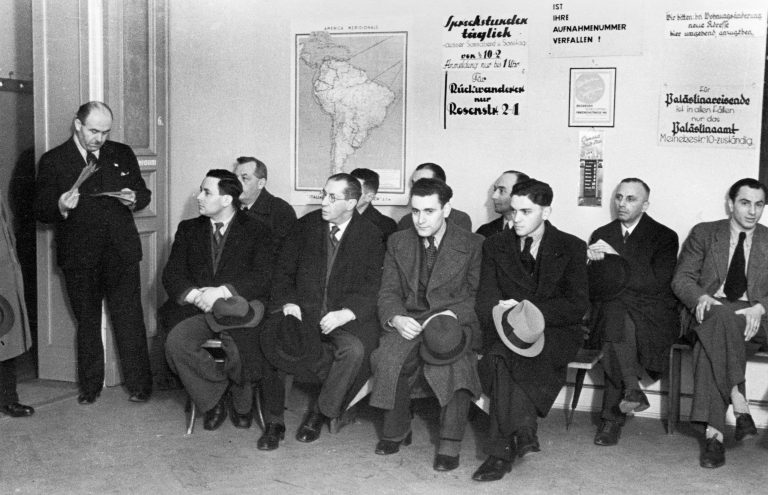
The waiting room of the Jewish aid association’s emigration counseling office, undated
The Hilfsverein der deutschen Juden (Aid Association of German Jews) is founded in Berlin in 1901 to support Jews from Eastern Europe. Between 1901 and 1913, it helps 200,000 Russian Jews emigrate overseas. After 1933, when Jews are no longer considered German under the Nazis, the association is forced to change its name to Hilfsverein der Juden in Deutschland (Aid Association of Jews in Germany). By 1941 it has helped some 90,000 German Jews emigrate overseas.
Photo: Abraham Pisarek / bpk 30045701
The waiting room of the Jewish aid association’s emigration counseling office, undated
The Hilfsverein der deutschen Juden (Aid Association of German Jews) is founded in Berlin in 1901 to support Jews from Eastern Europe. Between 1901 and 1913, it helps 200,000 Russian Jews emigrate overseas. After 1933, when Jews are no longer considered German under the Nazis, the association is forced to change its name to Hilfsverein der Juden in Deutschland (Aid Association of Jews in Germany). By 1941 it has helped some 90,000 German Jews emigrate overseas.
Photo: Abraham Pisarek / bpk 30045701
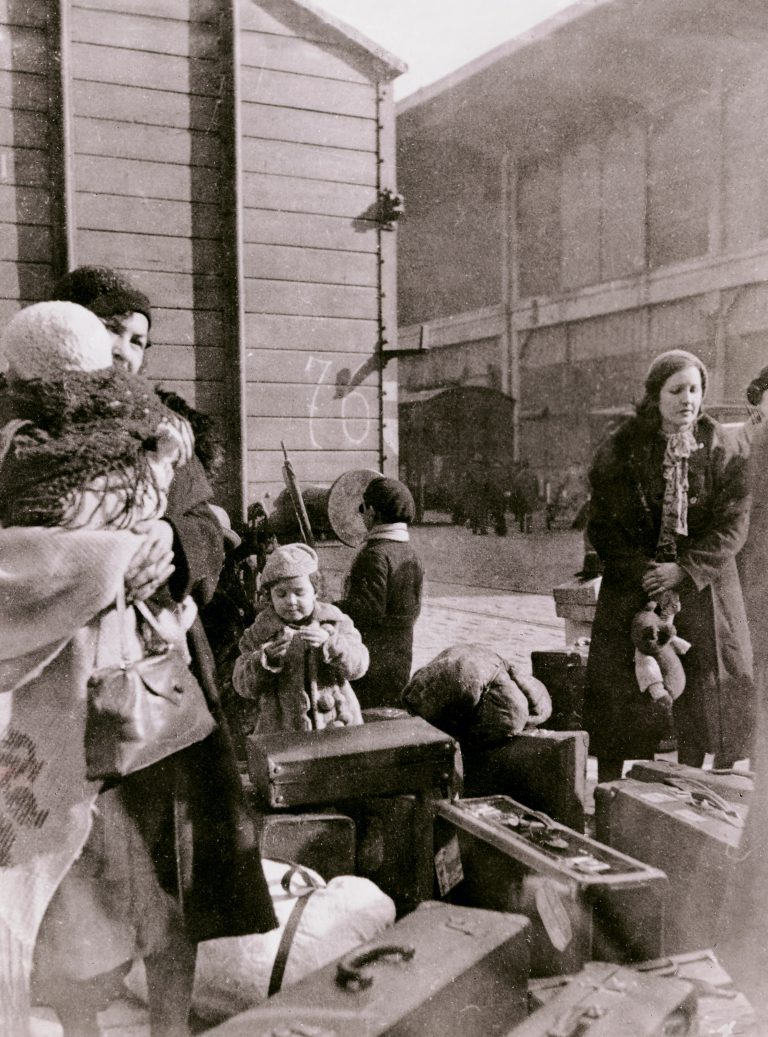
Jewish refugees waiting to receive an official permit to leave on a steamship to Palestine, ca. 1935.
American Jewish Joint Distribution Committee Archives, New York, NY
Jewish refugees waiting to receive an official permit to leave on a steamship to Palestine, ca. 1935.
American Jewish Joint Distribution Committee Archives, New York, NY

Emigrants to Palestine at Anhalter Station, September 1936
In September 1936, the Jewish Agency for Palestine’s Berlin office organizes a journey for 650 people from Berlin to Palestine within a few days, in order to preempt a British ban on new immigrants to Palestine.
Photo: Herbert Sonnenfeld / Jüdisches Museum Berlin
Emigrants to Palestine at Anhalter Station, September 1936
In September 1936, the Jewish Agency for Palestine’s Berlin office organizes a journey for 650 people from Berlin to Palestine within a few days, in order to preempt a British ban on new immigrants to Palestine.
Photo: Herbert Sonnenfeld / Jüdisches Museum Berlin
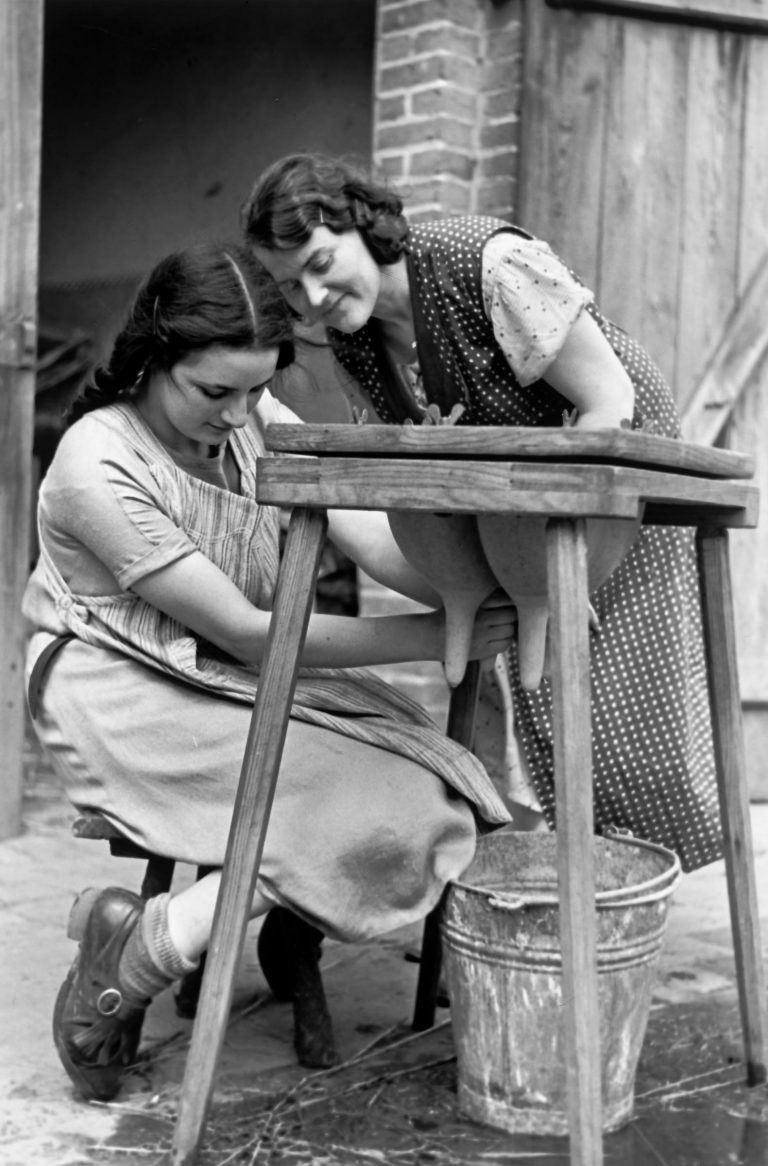
Two girls practice at a milking table with an artificial udder in the Hachschara camp Steckelsdorf near Rathenow, 1937
Settlers with agricultural know-how are in demand in Palestine. Many Latin American destination countries also only accept newcomers with experience in trades and agriculture. For this reason, both Zionist and non-Zionist Jewish organizations support training farms and centers where young people in particular can prepare for lives in exile.
Photo: Herbert Sonnenfeld / Jüdisches Museum Berlin
Two girls practice at a milking table with an artificial udder in the Hachschara camp Steckelsdorf near Rathenow, 1937
Settlers with agricultural know-how are in demand in Palestine. Many Latin American destination countries also only accept newcomers with experience in trades and agriculture. For this reason, both Zionist and non-Zionist Jewish organizations support training farms and centers where young people in particular can prepare for lives in exile.
Photo: Herbert Sonnenfeld / Jüdisches Museum Berlin






